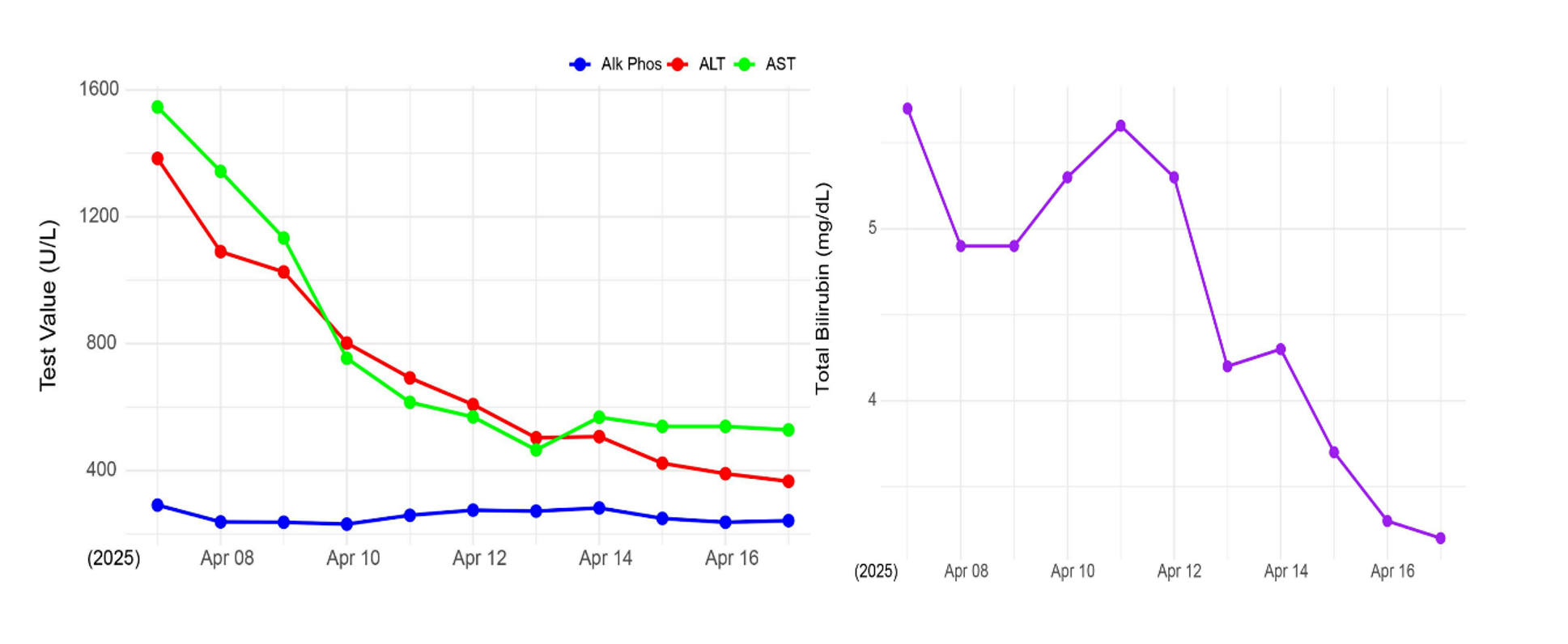Tuesday Poster Session
Category: Liver
P6098 - Epstein-Barr Virus-Triggered Autoimmune Hepatitis Presenting as Acute Pancreatitis: A Diagnostic Challenge
Tuesday, October 28, 2025
10:30 AM - 4:00 PM PDT
Location: Exhibit Hall

Abirami Rajendiran, MD (she/her/hers)
Texas Tech University Health Sciences Center
El Paso, TX
Presenting Author(s)
Abirami Rajendiran, MD, Bansi Sutariya, MD, Deipthan Prabakar, MD, Omer Usman, MD, Sandesh Murali, MD, Sherif E. Elhanafi, MD, Jyothsna Goranti, MD
Texas Tech University Health Sciences Center, El Paso, TX
Introduction: Epstein-Barr Virus (EBV) can present atypically in elderly patients, often mimicking conditions like pancreatitis or hepatitis. Acute pancreatitis typically has well-known causes, but rare infectious triggers like EBV should also be considered. We are presenting a case of a 60-year-old female with abdominal pain, later diagnosed with overlapping EBV infection and autoimmune hepatitis.
Case Description/
Methods: This is a 60-year-old female with a remote history of gallstones, status post cholecystectomy, who presented with diffuse abdominal pain. On presentation, her vital signs were notable for a heart rate of 110 bpm, blood pressure of 96/63 mmHg, and a mean arterial pressure (MAP) of 55 mmHg. She also required 2L of supplemental oxygen to maintain an SpO₂ of 93%, meeting the criteria for systemic inflammatory response syndrome (SIRS). Initial laboratory evaluation revealed marked elevation in liver enzymes, with an ALP of 291 U/L, ALT of 1384 U/L, and AST of 1546 U/L, consistent with acute hepatocellular injury. In response, the patient was initiated on intravenous fluid resuscitation and empiric broad-spectrum antibiotics. An abdominal MRI was performed during her hospitalization, which showed no evidence of biliary ductal dilation or choledocholithiasis. Further serologic workup was notable for positive Epstein-Barr Virus (EBV) serologies(Real-time PCR), elevated antinuclear antibody (ANA), and smooth muscle antibody (SMA), raising suspicion for autoimmune hepatitis. The patient was started on a course of steroids, which was gradually tapered as an outpatient. Pathology results confirmed early-stage autoimmune hepatitis with signs of early fibrosis and liver cell damage. Her condition improved with treatment, her liver tests returned to normal, and she continues to be followed as an outpatient.
Discussion: Epstein-Barr virus (EBV) has been associated with an increased risk of developing autoimmune hepatitis. In this case, the patient initially presented with acute pancreatitis and was subsequently found to have evidence of EBV infection. This case underscores the diagnostic challenges that can arise when infectious and autoimmune processes coexist, particularly in elderly patients with atypical presentations such as pancreatitis. It highlights the importance of maintaining a broad differential diagnosis and utilizing a systematic approach that incorporates clinical history, laboratory evaluation, and imaging to guide accurate diagnosis and management.

Figure: Figure 2

Figure: Figure 1
Disclosures:
Abirami Rajendiran indicated no relevant financial relationships.
Bansi Sutariya indicated no relevant financial relationships.
Deipthan Prabakar indicated no relevant financial relationships.
Omer Usman indicated no relevant financial relationships.
Sandesh Murali indicated no relevant financial relationships.
Sherif Elhanafi indicated no relevant financial relationships.
Jyothsna Goranti indicated no relevant financial relationships.
Abirami Rajendiran, MD, Bansi Sutariya, MD, Deipthan Prabakar, MD, Omer Usman, MD, Sandesh Murali, MD, Sherif E. Elhanafi, MD, Jyothsna Goranti, MD. P6098 - Epstein-Barr Virus-Triggered Autoimmune Hepatitis Presenting as Acute Pancreatitis: A Diagnostic Challenge, ACG 2025 Annual Scientific Meeting Abstracts. Phoenix, AZ: American College of Gastroenterology.
Texas Tech University Health Sciences Center, El Paso, TX
Introduction: Epstein-Barr Virus (EBV) can present atypically in elderly patients, often mimicking conditions like pancreatitis or hepatitis. Acute pancreatitis typically has well-known causes, but rare infectious triggers like EBV should also be considered. We are presenting a case of a 60-year-old female with abdominal pain, later diagnosed with overlapping EBV infection and autoimmune hepatitis.
Case Description/
Methods: This is a 60-year-old female with a remote history of gallstones, status post cholecystectomy, who presented with diffuse abdominal pain. On presentation, her vital signs were notable for a heart rate of 110 bpm, blood pressure of 96/63 mmHg, and a mean arterial pressure (MAP) of 55 mmHg. She also required 2L of supplemental oxygen to maintain an SpO₂ of 93%, meeting the criteria for systemic inflammatory response syndrome (SIRS). Initial laboratory evaluation revealed marked elevation in liver enzymes, with an ALP of 291 U/L, ALT of 1384 U/L, and AST of 1546 U/L, consistent with acute hepatocellular injury. In response, the patient was initiated on intravenous fluid resuscitation and empiric broad-spectrum antibiotics. An abdominal MRI was performed during her hospitalization, which showed no evidence of biliary ductal dilation or choledocholithiasis. Further serologic workup was notable for positive Epstein-Barr Virus (EBV) serologies(Real-time PCR), elevated antinuclear antibody (ANA), and smooth muscle antibody (SMA), raising suspicion for autoimmune hepatitis. The patient was started on a course of steroids, which was gradually tapered as an outpatient. Pathology results confirmed early-stage autoimmune hepatitis with signs of early fibrosis and liver cell damage. Her condition improved with treatment, her liver tests returned to normal, and she continues to be followed as an outpatient.
Discussion: Epstein-Barr virus (EBV) has been associated with an increased risk of developing autoimmune hepatitis. In this case, the patient initially presented with acute pancreatitis and was subsequently found to have evidence of EBV infection. This case underscores the diagnostic challenges that can arise when infectious and autoimmune processes coexist, particularly in elderly patients with atypical presentations such as pancreatitis. It highlights the importance of maintaining a broad differential diagnosis and utilizing a systematic approach that incorporates clinical history, laboratory evaluation, and imaging to guide accurate diagnosis and management.

Figure: Figure 2

Figure: Figure 1
Disclosures:
Abirami Rajendiran indicated no relevant financial relationships.
Bansi Sutariya indicated no relevant financial relationships.
Deipthan Prabakar indicated no relevant financial relationships.
Omer Usman indicated no relevant financial relationships.
Sandesh Murali indicated no relevant financial relationships.
Sherif Elhanafi indicated no relevant financial relationships.
Jyothsna Goranti indicated no relevant financial relationships.
Abirami Rajendiran, MD, Bansi Sutariya, MD, Deipthan Prabakar, MD, Omer Usman, MD, Sandesh Murali, MD, Sherif E. Elhanafi, MD, Jyothsna Goranti, MD. P6098 - Epstein-Barr Virus-Triggered Autoimmune Hepatitis Presenting as Acute Pancreatitis: A Diagnostic Challenge, ACG 2025 Annual Scientific Meeting Abstracts. Phoenix, AZ: American College of Gastroenterology.
